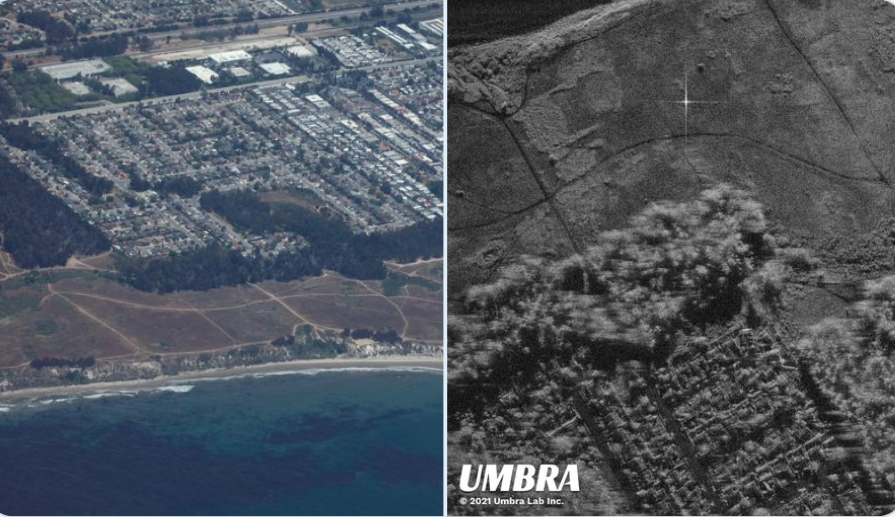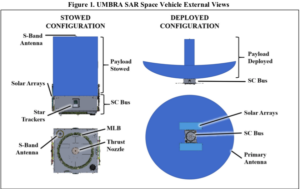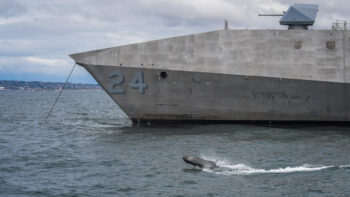
Umbra SAR test images, published June 15 on Twitter
WASHINGTON: California startup Umbra expects to launch its first synthetic aperture radar (SAR) satellite Friday — with an eye on the NRO’s planned buy of commercial SAR data later this year, Todd Master, the firm’s chief operating officer, says.
“We are absolutely trying to get into that US government market,” Master, who left DARPA in May to join Umbra, told us in an interview.
And the NRO’s official request for proposals (RFP) — which is expected to be released any day now following an initial request for industry information last November — provides Umbra with a first shot.
“We are keenly interested in that,” said Master, “that is a super high focus for us, getting in the door.”
Master explained that the NRO model, which is to buy commercial SAR data as a service matches Umbra’s own marketing model.
“We have a very specific desire to sell data, and not to sell a satellite, and not to sell analytics,” he explained. “So, that is right in our wheelhouse — exactly what we want to do — we want to sell commercial data. … Just buy our data, then you can use it to gap fill national assets; you can use it to augment; you can take the data and do whatever wizardry you want to combine it with what you already have.”
By contrast, Master explained, many commercial imagery providers today — whether of electro-optical or SAR — are moving toward a model that is heavily reliant on providing analytical products derived from the data their satellites collect. This is, in part, because more profitable analytics can offset the high costs of imagery satellite operations.
He noted that at the moment, the US government market writ large (which includes a number of civil agencies as well national security customers) for SAR-sat data makes up almost half of the global market.
Until 2020, national security restrictions made it impossible for US companies to sell SAR-sat imagery — with the NRO instead building its own top secret birds using classified contracts to a handful of big contractors. Since then, companies hoping to sell SAR satellites, data and analytics to the US government have been popping up like mushrooms — including foreign-established firms like Finland’s ICEYE and Airbus that are now opening US operations. And both NRO and the DoD are eager to take advantage, because proliferated SAR raises the tantalizing prospect of being able to detect and monitor changes at targeted sites (‘change detection’) or even track mobile targets from point to point.
Tiny Umbra — about 45 people today — has been working since its 2015 birth in what is often called ‘stealth mode’ in the venture capital world — keeping most of its plans under wraps. “The team that didn’t really talk a lot about what they’re doing for the first several years,” Master said.
The firm first announced in January that it had raised $32 million in financing, and that it intended to begin launching satellites this year and it has been awarded a patent for its deployable radar antenna. In March, it issued a press release to announce that it had obtained a license from the FCC for its first satellite; and on June 16 Umbra applied for an FCC license covering its initially planned constellation of five sats.
Master said the company plans to grow the constellation to at least 24 satellites, which will give it global coverage. They will operate in Low Earth Orbit, he said, at around 500 kilometers above the Earth. A LEO orbit allows the data gathered by the radar to be transmitted to users on the ground with little delay.
 But the key to the company’s marketing niche, Master said, is the patented antenna design. The antenna folds up “like origami” to fit in a very small package, but unfolds to create a very large aperture needed to see a wide swath of the ground and provide images down to about 15 centimeters resolution. That is about the size of a soda can, Master said — and, indeed, the company managed to detect four Red Bull cans on the ground in an airborne test of the radar (with power levels tweaked to represent its space-base capabilities).
But the key to the company’s marketing niche, Master said, is the patented antenna design. The antenna folds up “like origami” to fit in a very small package, but unfolds to create a very large aperture needed to see a wide swath of the ground and provide images down to about 15 centimeters resolution. That is about the size of a soda can, Master said — and, indeed, the company managed to detect four Red Bull cans on the ground in an airborne test of the radar (with power levels tweaked to represent its space-base capabilities).
According to a document provided to Breaking D, Umbra’s satellites fit within the standard for ESPA (Evolved Expendable Launch Vehicle (EELV) Secondary Payload Adapter) class satellites when the antenna is stowed. ESPA-class sats measure approximately 61 x 71 x 97 centimeters and weigh about 200 kilograms.
When the antenna is deployed on orbit, the “maximum physical dimensions of the space vehicle” are approximately 4 x 4 x 2 meters. (The company also has a very cool introductory video showing how the antenna unfurls.)
The small size of the satellites, in turn, allow Umbra to keep costs down. This is because meeting ESPA size and mass restrictions enables Umbra to use rideshare capacity on SpaceX’s reusable Falcon 9. The first launch will be part of SpaceX’s Transporter 2 mission, which is carrying some 88 small sats to LEO.
“In rough terms” I will say in many cases we are two orders of magnitude less than our competitors. And when I say competitors, I mean, two orders of magnitude less than like a traditional supplier.”
Thus, Master said, Umbra can offer SAR images for a lot less than the current going rate for SAR imagery of about $5,000 per ‘picture.’
Another key feature of Umbra’s business model, Master said, is that the firm intends to rely on “creative commons” licensing, which will allow customers to do whatever they wish with the SAR data once they buy it. This approach, too, departs from the traditional model of licenses for SAR data based on a single, internal use only, he explained.
‘The bad day’: DISA’s forthcoming strategy prepares for wartime coms
“It’s great to have internet day to day in peacetime,” said Lt. Gen. Robert Skinner, director of the Defense Information Systems Agency, “but it’s more imperative to have it when bullets are flying.”


























